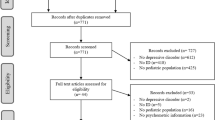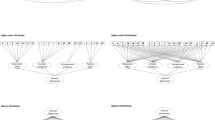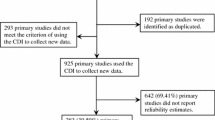Abstract
This study proposes a revision (R) of the Center for Epidemiologic Studies Depression Scale for youth with ID (CESD-ID) in English and French. 346 youth (36.02% girls) with mild (51.26%) and moderate (48.78%) ID (11–22 years; M = 15.69), enrolled in secondary schools in Canada (French-speaking; n = 115), and Australia (English-speaking; n = 231), as well as their parents and teachers, participated in this study. Results support the reliability, factor validity, equivalence (sex, ID level, comorbidities, and country), and convergent validity (with youth-, parent-, and teacher-rated measures of depression, anxiety, and loneliness/social isolation) of the CESD-ID-R. The CESD-ID-R allows youth with ID to provide a reliable and valid assessment of their depressive mood and happiness suitable for epidemiological studies.
Similar content being viewed by others
References
American Psychological Association [APA]. (2000). Diagnostic and statistical manual. American Psychological Association.
American Psychological Association [APA]. (2020). APA dictionary of psychology. American Psychological Association.
Asher, S. R., Hymel, S., & Renshaw, P. D. (1984). Loneliness in children. Child Development, 55, 1456–1464.
Asparouhov, T., & Muthén, B.O. (2010). Weighted least square estimation with missing data. http://www.statmodel.com/download/GstrucMissingRevision.pdf
Austin, K. L., Hunter, M., Gallagher, E., & Campbell, L. E. (2018). Depression and anxiety symptoms during the transition to early adulthood for people with intellectual disabilities. Journal of Intellectual Disability Research, 62, 407–721.
Berg, K. L., Shiu, C. S., Msall, M. E., & Acharya, K. (2015). Victimization and depression among youth with disabilities in the US child welfare system. Child: Care Health and Development, 41, 989–999.
Bollen, K. A. (1989). Structural equations with latent variables. Wiley.
Caspi, A., Houts, R. M., Belsky, D. W., Goldman-Mellor, S. J., Harrington, H., Israel, S., Meirer, M. H., Ramrakha, S., Shalev, I., Poulton, R., & Moffitt, T. E. (2014). The p Factor: One general psychopathology factor in the structure of psychiatric disorders? Clinical Psychological Science, 2, 119–137.
Chaplin, T. M., & Aldao, A. (2013). Gender differences in emotion expression in children: A meta-analytic review. Psychological Bulletin, 139, 735–765.
Charlot, L., Deutsch, C., Hunt, A., Fletcher, K., & McIlvane, W. (2007). Validation of the mood and anxiety semi-structured (MASS) interview for patients with intellectual disabilities. Journal of Intellectual Disability Research, 51, 821–834.
Chen, F. F. (2007). Sensitivity of goodness of fit indexes to lack of measurement invariance. Structural Equation Modeling, 14, 464–504.
Chester, R., Chaplin, E., Tsakanikos, E., McCarthy, J., Bouras, N., & Craig, T. (2013). Gender differences in self-reported symptoms of depression and anxiety in adults with intellectual disabilities. Advances in Mental Health and Intellectual Disabilities, 7, 191–200.
Cheung, G. W., & Rensvold, R. B. (2002). Evaluating goodness-of fit indexes for testing measurement invariance. Structural Equation Modeling, 9, 233–255.
Costello, E. J., Copeland, W., & Angold, A. (2011). Trends in psychopathology across the adolescent years: What changes when children become adolescents, and when adolescents become adults? The Journal of Child Psychology and Psychiatry, 52, 1015–1025.
Cuthill, F. M., Espie, C. A., & Cooper, S. A. (2003). Development and psychometric properties of the Glasgow Depression Scale for people with a learning disability. British Journal of Psychiatry, 182, 347–353.
Dagnan, D., Jahoda, A., McDowell, K., Masson, J., Banks, P., & Hare, D. (2008). The psychometric properties of the hospital anxiety and depression scale adapted for use with people with intellectual disabilities. Journal of Intellectual Disability Research, 52, 942–949.
Dovgan, K., Mazurek, M. O., & Hansen, J. (2019). Measurement invariance of the child behavior checklist in children with autism spectrum disorder with and without intellectual disability: Follow-up study. Research in Autism Spectrum Disorder, 58, 19–29.
Dwyer, S. B., Nicholson, J. M., & Battistuta, D. (2006). Parent and teacher identification of children at risk of developing internalizing or externalizing mental health problems: A comparison of screening methods. Prevention Science, 7, 343–357.
Enders, C. K. (2010). Applied missing data analysis. Guildford.
Esbensen, A. J., Rojahn, J., Aman, M. G., & Ruedrich, S. (2003). Reliability and validity of an assessment instrument for anxiety, depression, and mood among individuals with mental retardation. Journal of Autism and Developmental Disorders, 33, 617–629.
Esbensen, A. J., Seltzer, M. M., Greenberg, J. S., & Benson, B. A. (2005). Psychometric evaluation of a self-report measure of depression for individuals with mental retardation. American Journal of Mental Retardation, 110, 469–481.
Finney, S. J., & DiStefano, C. (2013). Nonnormal and categorical data in structural equation modeling. In G. R. Hancock & R. O. Mueller (Eds.), Quantitative methods in education and the behavioral sciences: Issues, research, and teaching. Structural equation modeling: A second course (pp. 439–492). Information Age Publishing.
Garber, J., & Rao, U. (2014). Depression in children and adolescents. In M. Lewis & K. D. Rudolph (Eds.), Handbook of developmental psychopathology (3rd ed., pp. 489–520). Springer.
GBD 2019 Diseases and Injuries collaborators. (2020). Global burden of 369 diseases and injuries in 204 countries and territories, 1990–2019: A systematic analysis for the Global Burden of Disease Study 2019. The Lancet, 396, 1204–1222.
Glenn, E., Bihm, E. M., & Lammers, W. J. (2003). Depression, anxiety, and relevant cognitions in persons with mental retardation. Journal of Autism and Developmental Disorders, 33, 69–76.
Hamers, P. C. M., van Ool, J. S., Festen, D. A. M., Hendriksen, J. G. M., Bindels, P. J. E., & Hermans, H. (2018). Reliability and validity of the Dutch Anxiety, Depression and Mood Scale in adult aged <50 years with intellectual disabilities. Journal of Applied Research in Intellectual Disabilities, 3, 568–574.
Hartley, S. L., & MacLean, W. E. (2006). A review of the reliability and validity of Likert scales for people with intellectual disability. Journal of Intellectual Disability Research, 50, 813–827.
Havercamp, S., & Reiss, S. (1997). The Reiss screen for maladaptive behavior: Confirmatory factor analysis. Behavior Research Therapy, 35, 967–971.
Hermans, H., & Evenhuis, H. M. (2010). Characteristics of instruments screening for depression in adults with intellectual disabilities: Systematic review. Research in Developmental Disabilities, 31, 1109–1120.
Hermans, H., Jelluma, N., van der Pas, F. H., & Evenhuis, H. M. (2012). Feasibility, reliability and validity of the Dutch translation of the Anxiety, Depression and Mood Scale in older adults with intellectual disability. Research in Developmental Disabilities, 33, 315–323.
Hermans, H., Wieland, J., Jelluma, N., van der Pas, F. H., & Evenhuis, H. M. (2013). Reliability and validity of the Dutch version of the Glasgow Anxiety Scale for people with an intellectual disability (GAS-ID). Journal of Intellectual Disability Research, 57, 728–736.
Hsieh, K., Scott, H. M., & Murthy, S. (2020). Associated risk factors for depression and anxiety in adults with intellectual and developmental disabilities: Five-year follow up. American Journal on Intellectual and Developmental Disabilities, 125, 49–63.
Hu, L. T., & Bentler, P. M. (1999). Cutoff criteria for fit indexes in covariance structure analysis: Conventional criteria versus new alternatives. Structural Equation Modeling, 6, 1–55.
Institut de la statistique du Québec (ISQ). (2018). Enquête québécoise sur la santé mentale des jeunes du secondaire 2016–2017. Résultats de la deuxième édition. L’adaptation sociale et la santé mentale des jeunes, Tome 2. www.stat.gouv.qc.ca
Keijsers, L., & Poulin, F. (2013). Developmental changes in parent–child communication throughout adolescence. Developmental Psychology, 49, 2301–2308.
Kemper, T. S., Nader, R. G., Repper, K. K., & Kistner, J. A. (2003). Mother-child agreement on reports of internalizing symptoms among children referred for evaluation of ADHD. Journal of Psychopathology and Behavioral Assessment, 25, 239–250.
Klein, A. M., Houtkamp, E. O., Salemink, E., Baartmans, J. M. D., Rinck, M., & van der Molen, M. J. (2018). Differences between self- and peer-rated likability in relation to social anxiety and depression in adolescents with mild intellectual disabilities. Research in Developmental Disabilities, 80, 44–51.
Lindsay, W. R., & Skene, D. D. (2007). The Beck depression inventory II and the Beck anxiety inventory in people with intellectual disabilities: Factor analyses and group data. Journal of Applied Research in Intellectual Disabilities, 20, 401–408.
Little, T. D. (2013). Longitudinal structural equation modeling. The Guildford Press.
Maïano, C., Coutu, S., Tracey, D., Bouchard, S., Lepage, G., Morin, A. J. S., & Moullec, G. (2018). Prevalence of anxiety and depressive disorders among youth with intellectual disabilities: A systematic review and meta-analysis. Journal of Affective Disorders, 236, 230–242.
Maïano, C., Morin, A. J. S., & Bégarie, J. (2011). The Center for Epidemiologic Studies Depression Scale: Factor validity and reliability in a French sample of adolescents with intellectual disability. Research in Developmental Disabilities, 32, 1872–1883.
Marsh, H. W., Hau, K.-T., & Grayson, D. (2005). Goodness of fit evaluation in structural equation modeling. In A. Maydeu-Olivares & J. McArdle (Eds.), Contemporary Psychometric (pp. 275–340). Erlbaum.
Marsh, H. W., Scalas, L. F., & Nagengast, B. (2010). Longitudinal tests of competing factor structures for the Rosenberg self-esteem scale: Traits, ephemeral artifacts, and stable response styles. Psychological Assessment, 22, 366–381.
Martin, L., Hirdes, J. P., Fries, B. E., & Smith, T. F. (2007). Development and psychometric properties of an assessment for persons with intellectual disability—the interRAI ID. Journal of Policy and Practice in Intellectual Disabilities, 4, 23–29.
Masi, G., Brovedani, P., Mucci, M., & Favilla, L. (2002). Assessment of anxiety and depression in adolescents with mental retardation. Child Psychiatry and Human Development, 32, 227–237.
Matikka, L. M., & Ojanen, M. (2004). Happiness in persons with intellectual disabilities. European Journal of Mental Disability, 29, 3–18.
Matson, J. L., Baglio, C. S., Smiroldo, B. B., Hamilton, M., Packlowskyi, T., Williams, D., & Kirkpatrick-Sanchez, S. (1996). Characteristics of autism as assessed by the diagnostic assessment for the severely handicapped-II (DASH-II). Research in Developmental Disabilities, 17, 135–143.
Matson, J. L., & Bamburg, J. W. (1998). Reliability of the assessment of dual diagnosis (ADD). Research in Developmental Disabilities, 19, 89–95.
McDonald, R. P. (1970). The theoretical foundations of principal factor analysis and alpha factor analysis. British Journal of Mathematical and Statistical Psychology, 23, 1–21.
Meins, W. (1993). Assessment of depression in mentally retarded adults: Reliability and validity of the children’s depression inventory (CDI). Research in Developmental Disabilities, 14, 299–312.
Meins, W. (1996). A new depression scale designed for use with adults with mental retardation. Journal of Intellectual Disability Research, 40, 222–226.
Mileviciute, I., & Hartley, S. L. (2015). Self-reported versus informant-reported depressive symptoms in adults with mild intellectual disability. Journal of Intellectual Disability Research, 59, 158–169.
Millsap, R. (2011). Statistical approaches to measurement invariance. Taylor & Francis.
Mindham, J., & Espie, C. A. (2003). Glasgow Anxiety Scale for people with an intellectual disability (GAS-ID): Development and psychometric properties of a new measure for use with people with mild intellectual disability. Journal of Intellectual Disability Research, 47, 22–30.
Morin, A. J. S., Moullec, G., Maïano, C., Layet, L., Just, J. L., & Ninot, G. (2011). Psychometric properties of the Center for Epidemiologic Studies Depression Scale (CES-D) in French clinical and nonclinical adults. Epidemiology and Public Health, 59, 327–340.
Muthén, L., & Muthén, B. (2019). Mplus user’s guide. Muthén & Muthén.
Nolen-Hoeksema, S. (2012). Emotion regulation and psychopathology: The role of gender. Annual Review of Clinical Psychology, 8, 161–187.
Olivier, E., Azarnia, P., Morin, A. J. S., Houle, S. A., Dubé, C., Tracey, D., & Maïano, C. (2020). The moderating role of teacher-student relationships on the association between peer victimization and depression in students with intellectual disabilities. Research in Developmental Disabilities, 98, 1–11.
Perez-Achiaga, N., Nelson, S., & Hassiotis, A. (2009). Instruments for the detection of depressive symptoms in people with intellectual disabilities. Journal of Intellectual Disabilities, 13, 55–76.
Polanczyk, G. V., Salum, G. A., Sugaya, L. S., Caye, A., & Rohde, L. A. (2015). Annual research review: A meta-analysis of the worldwide prevalence of mental disorders in children and adolescents. Journal of Child Psychology and Psychiatry, 56, 345–365.
Powell, R. (2003). Psychometric properties of the Beck depression inventory and the Zung Self-Rating Depression Scale in adults with mental retardation. Mental Retardation, 41, 88–95.
Prosser, H., Moss, S., Costello, H., Simpson, N., Patel, P., & Rowe, S. (1998). Reliability and validity of the Mini PAS-ADD for assessing psychiatric disorders in adults with intellectual disability. Journal of Intellectual Disability Research, 42, 264–272.
Radloff, L. S. (1977). The CES-D scale: A self-report depression scale for research in the general population. Applied Psychological Measurement, 1, 385–401.
Reynolds, W. M., & Baker, J. A. (1988). Assessment of depression in persons with mental retardation. American Journal on Mental Retardation, 93, 93–103.
Roid, G. H., & Miller, L. J. (1997). Leiter International Performance Scale-revised. Stoelting.
Rojahn, J., Rowe, E. W., Kasdan, S., Moore, L., & van Ingen, D. J. (2011). Psychometric properties of the aberrant behavior checklist, the Anxiety, Depression and Mood Scale, the assessment of dual diagnosis and the social performance survey schedule in adults with intellectual disabilities. Research in Developmental Disabilities, 32, 2309–2320.
Ross, E., & Oliver, C. (2003). Preliminary analysis of the psychometric properties of the mood, interest & pleasure questionnaire (MIPQ) for adults with severe and profound learning disabilities. British Journal of Clinical Psychology, 42, 81–93.
Salbach-Andrea, H., Lenz, K., & Lehmkuhl, U. (2008). Patterns of agreement among parent, teacher and youth ratings in a referred sample. European Psychiatry, 24, 345–351.
Santor, D. A., Gregus, M., & Welch, A. (2006). Focus article: Eight decades of measurement in depression. Measurement: Interdisciplinary Research and Perspectives, 4, 135–155.
Satici, S. A., Uysakm, R., & Deniz, M. E. (2016). Linking social connectedness to loneliness: The mediating role of subjective happiness. Personality and Individual Differences, 97, 306–310.
Siddaway, A. P., Wood, A. M., & Taylor, P. J. (2017). The center for epidemiologic studies-depression (CES-D) scale measures a continuum from well-being to depression: Testing two key predictions of positive clinical psychology. Journal of Affective Disorders, 213, 180–186.
Skrondal, A., & Laake, P. (2001). Regression among factor scores. Psychometrika, 66, 563–576.
Smith, S. R. (2007). Making sense of multiple informants in child and adolescent psychopathology, a guide for clinicians. Journal of Psychoeducational Assessment, 25, 139–149.
Sturmey, P., Newton, J. T., Cowley, A., Bouras, N., & Holt, G. (2005). The PAS-ADD checklist: Independent replication of its psychometric properties in a community sample. British Journal of Psychiatry, 186, 319–323.
Turk, V., Khattran, S., Kerry, S., Corney, R., & Painter, K. (2012). Reporting of health problems and pain by adults with an intellectual disability and by their carers. Journal of Applied Research in Intellectual Disabilities, 25, 155–165.
Watson, J. E., Aman, M. G., & Singh, N. N. (1988). The psychopathology instrument for mentally retarded adults: Psychometric characteristics, factor structure, and relationship to subject characteristics. Research in Developmental Disabilities, 9, 277–290.
Wechsler, D. (2003). Wechsler Intelligence Scale for children-fourth edition. Pearson.
Wechsler, D., Coalson, D. L., & Raiford, S. E. (2008). WAIS-IV technical and interpretive manual. Pearson.
Weinberger, A. H., Gbedemah, M., Martinez, A. M., Nash, D., Galea, S., & Goodwin, R. D. (2018). Trends in depression prevalence in the USA from 2005 to 2015: Widening disparities in vulnerable groups. Psychological Medicine, 48, 1308–1315.
Whitney, D. G., Shapiro, D. N., Paterson, M. D., & Warschausky, S. A. (2019). Factors associated with depression and anxiety in children with intellectual disabilities. Journal of Intellectual Disability Research, 63, 408–417.
Wood, A. M., Taylor, P. J., & Joseph, S. (2010). Does the CES-D measure a continuum from depression to happiness? Comparing substantive and artifactual models. Psychiatry Research, 177, 120–123.
World Health Organization. (2019). Mental health. Retrieved June 14, 2021, from https://www.who.int/features/factfiles/mental_health/en/
Youngstrom, E., Loever, R., & Stouthamer-Loeber, M. (2000). Patterns and correlates of agreement between parent, teacher, and male adolescent ratings of externalizing and internalizing problems. Journal of Consulting and Clinical Psychology, 68, 1038–1050.
Yu, C. Y. (2002). Evaluating cutoff criteria of model fit indices for latent variable models with binary and continuous outcomes. University of California.
Acknowledgments
This study was supported by Grants from the Australian Research Council (DP140101559) and from the Social Science and Humanities Research Council of Canada (430-2012-0091, 435-2014-0909). In the preparation of this paper, the first author was also supported by funding from the Canadian Institute for Military and Veteran Health Research (CIMVHR), the third author by a grant from the Social Science and Humanities Research Council of Canada (435-2018-0368), and the fourth author by a doctoral scholarship from the Social Science and Humanities Research Council of Canada.
Author information
Authors and Affiliations
Contributions
EA involved in conceptualization, methodology, analyses, and writing (original draft, review, editing); CL, SAH, and CG, involved in conceptualization, methodology, analyses, and writing (original draft, editing); AJSM involved in funding (both countries), study design (both countries), data collection (Australia), conceptualization, methodology, analyses, and writing (original draft, review, editing); DT and RGC involved in funding (Australia), study design (Australia), data collection (Australia), and writing (original draft, review, editing); CM involved in funding (both countries), study design (both countries), data collection (Canada), conceptualization, methodology, and writing (original draft, review, editing).
Corresponding author
Ethics declarations
Conflict of interest
The authors have no conflict of interest to declare.
Additional information
Publisher's Note
Springer Nature remains neutral with regard to jurisdictional claims in published maps and institutional affiliations.
Supplementary Information
Below is the link to the electronic supplementary material.
Rights and permissions
About this article
Cite this article
Olivier, E., Lacombe, C., Morin, A.J.S. et al. Validation of a Revised Version of the Center for Epidemiologic Depression Scale for Youth with Intellectual Disabilities (CESD-ID-R). J Autism Dev Disord 52, 4554–4567 (2022). https://doi.org/10.1007/s10803-021-05334-9
Accepted:
Published:
Issue Date:
DOI: https://doi.org/10.1007/s10803-021-05334-9




